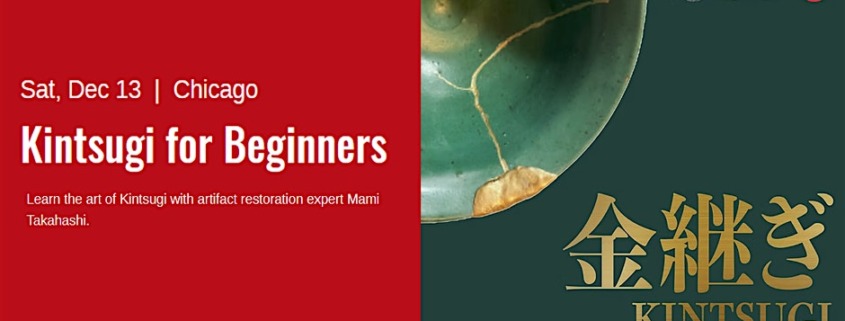
This beginner’s workshop introduces participants to the Art of Kintsugi, a traditional Japanese technique of repairing broken ceramics with gold-infused lacquer, emphasizing the beauty of imperfections. Using a small porcelain or ceramic plate provided by the instructor, attendees will learn fundamental techniques with food-safe materials, including artificial Urushi resin, epoxy putty, and ceramic glue. Designed for those interested in Kintsugi, this hands-on experience offers a safe and accessible way to explore its philosophy of resilience and transformation.
This event is a collaboration between Japanese Culture Center and Heritage Museum of Chicago.
Kintsugi is a traditional Japanese lacquer/Urushi art form in which gold mixed with natural lacquer-tree sap is used to repair broken ceramics. The practice of Kintsugi highlights the break rather than erasing it and emphasizes that the break, or trauma, is what makes the ceramics more valuable.
Here is a quote about Kintsugi from Linda Muller, a certified life coach:
“Kintsugi is based on the philosophy that breakage and repair are something to celebrate – embracing flaws and imperfections creates a stronger and more beautiful piece of art. Using this as a metaphor for healing ourselves teaches us an important lesson: Sometimes in the process of repairing what feels broken, we become more unique, beautiful and resilient. Kintsugi can be a way to reframe personal challenges. Reminding us that we’re not a victim of our circumstances. Showing us that we can come out on the other side stronger.”
In this beginner’s workshop, participants will learn the basic technique of Kintsugi on a small porcelain plate or a small ceramic plate, which the instructor will provide, to understand the fundamentals of this process. All materials including adhesives in the workshop will be food-safe. We will also use an artificial Urushi (the natural resin/glue collected from the lacquer tree) sap for this beginner’s class, which is safe to touch without allergy reactions.
Note: This workshop also uses epoxy putty and ceramic glue. Some remnants from these may stay on participants’ fingers. Finger covers will be provided but it could make a difficult to work on the details.
Accessibility:
The Heritage Museum of Asian Art’s Entrance is on West 35th Street. Take the elevator to the third floor and turn right to the Museum Reception Desk. Accessible and standard toilets are located on the same floor. Free parking space is available next to the museum via West 35th Street.
Artist Bio:
Mami Takahashi is a Japanese multidisciplinary artist and scholar in Chicago. She received her MFA in Contemporary Studio Practice from Portland State University in 2013 and earned a BFA in Japanese Painting from Joshibi University of Art and Design in Japan.
With ongoing artistic research, practice, and teaching, Takahashi explores different approaches to actualize Japanese aesthetics to enhance cultural perspectives in many U.S. communities. She is expanding her creativity to incorporate more specific discourses around society, past and present via a lens of Japanese art. Takahashi also aims to connect Japan and Chicago by teaching traditional and modern art-making techniques.




